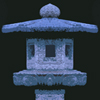This page is meant to help persons interested in the senryu genre orient themselves to the differences between haiku and senryu and to current Western senryu practice. The information on this site has been developed from discussions on the World Haiku Club's Senryu E-Forum and from searches for senryu-related sites on the Internet.
A word of warning. If you are looking for a definitive answer to the question, "What is senryu and how does it differ from haiku?" you will not find it here.
But you will find some useful information and gain insight into the form. Like Western haiku, Western senryu is still in the process of being defined.
 Example: A senryu of mine published in Simply Haiku: Example: A senryu of mine published in Simply Haiku:
first meditation class
he begins by contemplating
the blonde's navel
 Examples of Senryu from Simply Haiku 6:2 Summer 2008 Examples of Senryu from Simply Haiku 6:2 Summer 2008
 Definition of senryu by Alan Pizzarelli, Senryu Editor, Simply Haiku: Definition of senryu by Alan Pizzarelli, Senryu Editor, Simply Haiku:
Senryu is a short poetic genre which focuses on people. Men, women, husbands, wives, children and relatives. It portrays the characteristics of human beings and psychology of the human mind. Even when senryu depict living things such as animals, insects, and plant life, or when they depict inanimate objects, they are portrayed with the emphasis on their human attributes.
The senryu can make use of poetic devices such as simile, personification, and metaphor. It can also employ puns, parody and satire. Unlike haiku, senryu are not reliant on a seasonal or nature reference, but they DO occasionally use them. When they do, it is secondary to the human comedy or drama underlying the poem.
Senryu are not all strictly intended to be humorous. Many senryu express the misfortunes, the hardships and woe of humanity.
As a poet, I have always found that one of the best ways to understand a particular poetic form is to read fine examples of the poetry itself. As editor, it is my intention to select the best possible examples of authentic English-language senryu that span the full range of the genre, in an effort to promote a better understanding and appreciation of senryu poetry.
 Definition by Hiroaki Sato Definition by Hiroaki Sato
Unlike the haiku which normally deals with natural or seasonal phenomena, the senryû is expected to deal with matters of human and social nature, often in a playful, satirical, or knowing manner. The haiku carries a seasonal reference; the senryû does not have to. The distinction between the two genres has been tenuous, however, from early on. In recent years the blurring of the differences has become such that Ônishi Yasuyo has said, “If someone asks me how senryû differ from haiku, I tell the inquirer that the only distinction that can be made is by author’s name”—that is, if the author is known to write haiku, the pieces he or she writes are haiku; if the author is known to write senryû, the pieces she or he writes are senryû.
 Definition by Jane Reichhold, Aha Poetry Definition by Jane Reichhold, Aha Poetry
Senryu in Japanese means "River Willow." It is the pen name of the most famous poet who conducted maekuzuki (linking contests) has been given to this genre in his dubious honor. Because haiku and senryu are written much alike, often on the same subjects and usually by the same authors, great controversies have ensued over which is what. For a time, in America, senryu were considered to be faulty haiku. Actually, if one must differentiate, the senryu form is satiric, concerned with poking fun at human behavior as opposed to the profound, sublime world of nature where haiku shine.
 Definition by Michael Dylan Welch [from the Atlantic Monthly Word Games Senryu Content] Definition by Michael Dylan Welch [from the Atlantic Monthly Word Games Senryu Content]
A good senryu is not merely a knee-slapper, though it can be that. It's not just a showcase for puns or wit, although a good senryu can include cleverness or humour as part of a more resonant purpose. Rather, a senryu is a poem that wakes us up in a small way with its distilled, one-breath moment of heightened awareness focusing on human nature. It's a window into the human condition, freshly squeegeed. Senryu are, ultimately, poems of human self-awareness. They don't have to be funny, but often it is good to laugh at ourselves through senryu.
 Definition and Comments by Donald Keene, "World Within Walls: Japanese Literature of the Pre-Modern Era, 1600-1867", Holt, Rinehart, Winston, ©1976, ISBN 0-03-013626-1, p. 527. Definition and Comments by Donald Keene, "World Within Walls: Japanese Literature of the Pre-Modern Era, 1600-1867", Holt, Rinehart, Winston, ©1976, ISBN 0-03-013626-1, p. 527.
The difference between a comic haikai and a senryû are hard to define, but we might say that in general, haikai poetry deals with nature and senryû with human beings. This choice of subject matter is reflected by the insistence on seasonal words (kigo) in haikai poetry, but not in senryû. Haikai, at its best, tries to capture in seventeen syllables both the eternal and the momentary, but senryû is content with a single sharp observation. The importance of the "cutting words" (kireji) in
haikai stemmed largely from the division they established between the two elements they contained, but a senryû needed no cutting words, since only one element was present. The language of senryû is generally that of the common people, and is sometimes even vulgar, but haikai, despite its occasional daring uses of such words, was essentially restricted to the vocabulary of the man of taste. Parts of speech that were considered inconclusive in a haikai often ended a senryû, as if to signify it was flash of wit rather than a rounded-off poem.

|

